Pre-amble: I’ve taken a travel year with my family, heading more or less East until we find ourselves back in Quebec (or prove the Flat-Earthers correct!) I’ve always liked to read something from the places I travel to, and I thought it would make a fun quest to explore the world simultaneously through the books of each country we visit. Like a literary Anthony Bourdain.
Of course, we can’t pretend to understand a culture from a few books; we aren’t going to catalyze a series of epiphanies and insights here… …no, OK, we can pretend. And pretending is fun. And cultures are different. Arts are different. Sensibilities and worldview differ. What a boring world it would be otherwise!
And if this project doesn’t turn up any cultural insights—which I’ll be honest, insights are pretty far between for me—it will still be fun. So let’s go.
Amble:
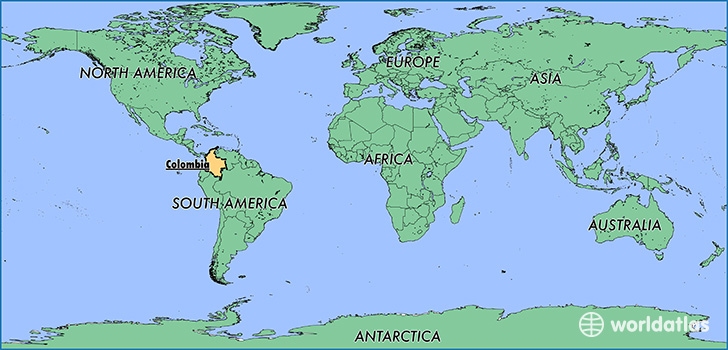
Colombia! The start of our round the globe journey, and of this global literary treasure hunt. The kids were stoked for adventure and discovery, the wife and I were excited, and I was fresh off Tom Wolfe’s Bonfire of the Vanities (8.6/10), high on good reads, and hungry to find another great one. (I have a decades-old habit of rating my books out of 10, and since they always seem to come in between 7 and 9, there’s a lot of usage of decimal places.)
I may as well admit this up front: I’m a sucker for the big names. I can’t stand the idea of missing something masterpiece-ful. It’s the same thing traveling: while I dream of off-the-beaten-path discovery, I’m always a sucker for the prime destinations, the ones all travellers flock to.
In Colombia, there is no such all-world travel destination, no Machu Picchu or Eiffel Tower, but in the book-world, there is no name bigger than Nobel Prize winner Gabriel Garcia Marquez—called, matter-of-fact-ly, one of the greatest writers of the 20th century in the first sentence of his Encyclopedia Brittanica bio. Also, probably Colombia’s second most famous son, after his great literary, romantic, and Jenga rival, Pablo Escobar.


We were staying in Cartagena, in Old Cartagena, where Garcia Marquez had lived, or kept a home, for decades–colourful, Spanish Colonial architecture, terra cotta roofs, flowered vines creeping down from ornate balconies, $3 dollar lunches of fried fish and rice, 330-days of sun a year.

He wrote Love In The Time of Cholera here. There’s a three-hour walking tour dedicated to GGM-touched sites. We didn’t take the tour, but anyway, it exists.
In university I’d read his most famous novel, One Hundred Years of Solitude. This is a Revered Book. If you had a wine-drinking hippie girlfriend in university, you’ve read it, or at least seen it on a shelf. And this isn’t the kind of thing you say in public, but between us: meh. It had lots of great pages. Just not in a row. It’s a multi-generational story, and there’s a built in flaw there. We want to follow characters, right? Not institutions, not families. So when a character dies, and we’re supposed to just hop on the next generation’s storyline, fatigue inevitably sets in. You have to write like a titan to pull this off, and Gabe didn’t. So, One Hundred Years of Solitude was a patchwork of great little stories, and ones I’d as soon skim through. All of which is to say, I was gonna skip Colombia’s most famous novel this time around. Now, that should have been enough to warn me off Garcia Marquez. I mean, there must be plenty of great Colombian writers to choose from, right? But, being a sucker for the big names, I wanted to see what else Garcia Marquez had done for that Nobel prize.
I began The General In His Labyrinth.

The premise sounded wonderful: following the Liberator, Simon Bolivar through the labyrinth of his thoughts in his last days. This was the story of the revolutionary leader who had ended colonial Spanish rule in modern Venezuela, Colombia, Panama, Bolivia and Peru, then found himself rejected by the republics he founded. Destitute. Despised. In horrible health and declining sanity. Sounds intriguing, no? Cartagena itself is labyrinthine, tiny alleys winding in ways I never could decipher, all terminating at the old city walls. With Cartagena itself figuring prominently in the book, it seemed a fitting read. Bolivar is a giant of world history, revered today throughout South America, and I knew so little of his life and career, let alone his decline and death, that I jumped into this with great excitement.
And: meh!
Not to get all literary theory on you, but this is what we call very so-so. Of the three GGMs I read in a month in Colombia, this was the most similar to One Hundred Years of Solitude, in terms of that dreamlike feel that GGM is famous for. He is known as a magical-realist, which I’ve never really understood. Incidentally, the country’s new tourist slogan is “Colombia, Magical Realism” which does have a nice ring to it, and gives you an idea how prominent Garcia Marquez sits in Colombian culture.
One Hundred Years of Solitude has, as I say, a dreamlike quality, but there’s very little magic in it, it feels almost entirely real-world and solid-earth. The General in His Labyrinth is even more so. There is no magic in it that I can see. It’s a plodding tale of Bolivar’s final march, accompanied by his last loyal officers, as they make their way from Bogota down the Magdalena River to the Caribbean coast and Cartagena, and the supposed ship to retirement in Europe that never materializes. The novel is a travelogue broken up by Bolivar’s recollections, and those of a few of his entourage. GGM is, by his own life experience, intimately acquainted with every bend in the Magdalena River… and he tells us about each of them. It’s a verbose and flowery book, that can’t get away with it because there’s not enough plot, thread, or theme to hold it together, to make you care.
The interspersed recollections are told in no particular order (chronological, alphabetical, whatever). For a reader unfamiliar with Bolivar’s history, it becomes quite confusing trying to piece together what happened when, and even what is happening now. If there could have been some thread tying these together, and tying all of that into the ‘now’ story, all culminating in some climax or reveal, then MAN, we could have a story.
But we don’t. Just a bunch of vignettes, some interesting, some useless, strung out along a very boring travelogue. Then he dies. Was I supposed to say Spoiler Alert there?
The tantalizing prospect of being in Bolivar’s mind is really copped-out-upon. We get memories of various battles and adventures, some of which are great in and of themselves, but almost nothing interesting of the here and now: scant reflection on the whole, on the present or future. It really feels like Garcia Marquez chickened out. Even the recollections have very little of personal commentary to them, they are simply first-person tales, albeit padded with Colombian flowery verbiage. We get things like this:
“Dancing was for him so dominant a passion that he would dance without a partner when one was not at hand, or he would dance alone to music he whistled himself, and he would express his moments of great jubilation by dancing on the dining room table.”
Now, that’s great as far as it goes – but that’s as far as it goes. That’s as personal as we get with the General. The book was written in 1989 But it presages the modern misplacement of personal trivia and minutia with intimacy, as in David Egger’s A Heartbreaking Work of Staggering Genius (2000), or Keeping Up With The Kardashians.
Garcia Marquez, in explaining what he wanted to explore in this work, said, “no one ever said in Bolivar’s biographies that he sang or that he was constipated.” So Marquez does. But you know, just because no one’s ever done something doesn’t necessarily mean you should. Yes, hearing him sing, feeling his constipation, those are nice storytelling details but a little less constipation and a little more mento-emotional action (as Elvis almost sang) would have been better. Garcia Marquez even has the good luck that Bolivar had with him a long standing, infinitely loyal confidante and aide-de-camp, with whom one could expect some good old soul searching conversations to take place, or at least to reveal some more personality. Instead, Garcia Marquez gives us the banal.
Other reviews of this book, I have to tell you, are full of shit. Margaret Atwood wrote one in the New York Times for example that almost made me puke.
“Had Bolivar not existed, Mr. Garcia Marquez would have had to invent him. Seldom has there been a more fitting match between author and subject. Mr. Garcia Marquez wades into his flamboyant, often improbable and ultimately tragic material with enormous gusto, heaping detail upon sensuous detail, alternating grace with horror, perfume with the stench of corruption, the elegant language of public ceremony with the…”
…blah bla-bla bla-blah.
No.
What she means is, it’s wordy and self indulgent and boring. She just tells us in code. The review goes on, but just more. Like the book. I can’t blame her, it takes a lot of words to make this mess a masterpiece, and she takes them.
I did learn a lot about Bolivar and South American history though, so it wasn’t a complete waste of time. For example, Bolivia is named for Bolivar. I felt like Roger DeBris, the director in The Producers describing the musical “Springtime For Hitler”:
“Did you know, I never knew that the Third Reich meant Germany. I mean it’s just drenched with historical goodies like that.”
(Also from Roger DeBris: “Will the dancing Hitlers please wait in the wings?”)
I’ll give The General a 7.5/10, on account of its lack of plot movement, lazy structure, and wordiness, versus the occasionally vividly wrought scenes, exciting flashbacks, some nice poetry, and the history lesson. So that’s my review of The General In His Labyrinth.
Did I mention how great Cartagena was? Outside Old Cartagena, there’s a beautiful neighbourhood called Getsemani, the old slaves’ quarter, hosting beautiful colonial architecture, stunning graffiti art, and backpackers everywhere (Old Cartagena is too touristy now, so all the tourists stay in Getsemani.)

The view of Old Cartagena on a wall in Getsemani 
Incognito at Backpacker Corner in Getsemani 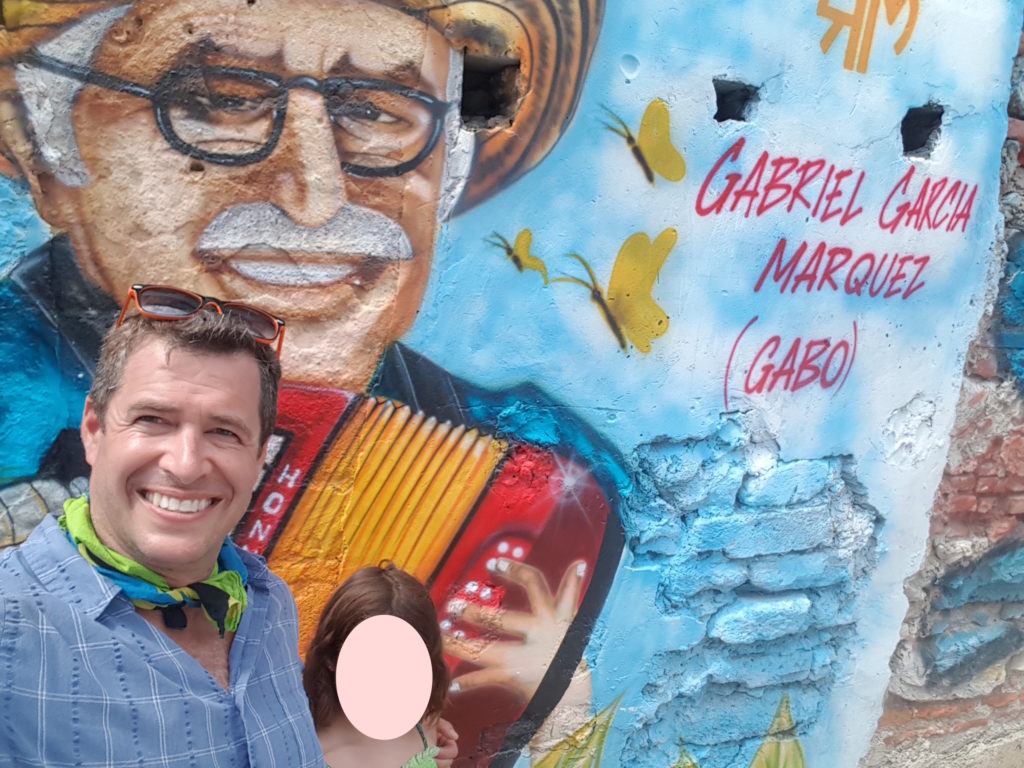
Well, look who I ran into 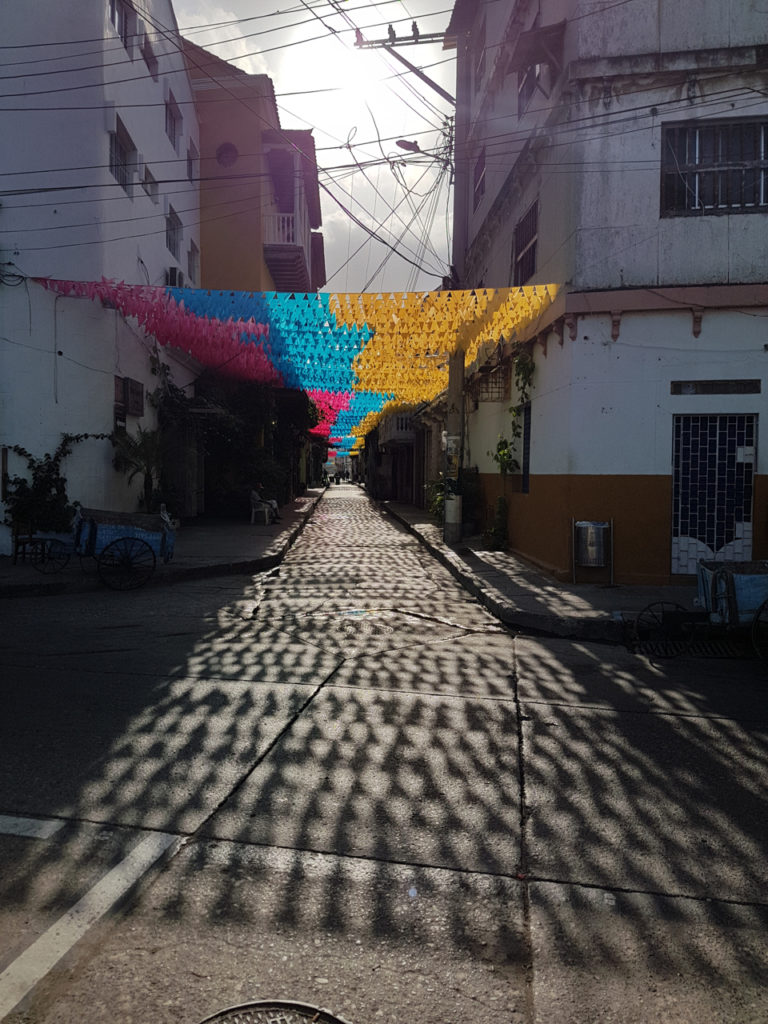

Garcia Marquez was passionate about Cartagena football. As far as I know. I have no idea. Could be. 
Old Cartagena 
I wasn’t done with GGM yet. There must be more there, I thought. But I didn’t want to suffer through something similar for my next choice, so I looked for the GGM with the most straightforward, un-artsy-fartsy plot. And I found it with The Story of a Shipwrecked Sailor.
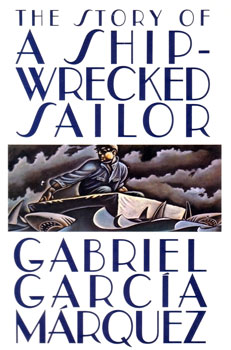
This was a true story, a collaboration between the eponymous sailor and Garcia Marquez, the reporter the tale was told to. The book was originally released as a newspaper serial, apparently causing quite a stir in Colombia, and backlash from the embarrassed dictatorship of the time. Gabe shows no excitement in the foreword introducing the re-release of the story decades later:
“If it is now published in the form of a book, that is because I agreed without thinking about it very much, and I am not a man to go back on my word.”
That said, it’s a ripping yarn. I’d looked for the anti-One Hundred Years, and this was it. We’d left Cartagena for the small beach town of Palomino by the time I began, and this was a great beach read. The Story of a Shipwrecked Sailor is the very simple adventure tale of a Colombian navy-man thrown overboard during heavy seas on a voyage home from the U.S.
Several of his comrades are also thrown; only the narrator survives, making it into a life raft, watching the others sink under the waves one by one, and then enduring ten days alone and adrift in the open sun, daily visited by sharks.
Now that’s a story that goes from A to B! There’s not much there, in terms of themes or symbolism, but also no wasted words or obscuring poetry. It’s far from typical GGM (I feel qualified to say now, as a reader of four of his books). It also gives you the feeling that the book belongs more to the sailor (who GGM even introduces in the foreword as a natural storyteller) than to GGM as the interpreter and typist. So, it’s almost cheating to recommend this as a Garcia Marquez book, because its not a real Garcia Marquez experience. Just a great, fast, pulse-quickening adventure story.
It happens that in Palomino, the waves are unusually powerful, so as I read on the beach and my kids built sand castles or jumped in the whitewater, I’d have to occasionally run out to keep them from being swept out to sea themselves. So, you know, I could empathize with the guy. I’ll give The Story of a Shipwrecked Sailor a solid 8/10 as a great adventure tale, completely lacking anything under the surface.
Here, I wrote a song on the beach in Palomino. Its called, On the Beach in Palomino. I recorded it in a hostel a few weeks later in Argentina. Go ahead, listen to it! You wouldn’t make fun, would you?
Speaking of music, Palomino, it turns out, is Guitar City, South America. Its almost entirely South American travellers, and every other one has a guitar on his back. On the beach one morning, I met a salsa-reggae band slowly waking up. They were from Bogota, if I remember right, and they became my new favourite band. I jammed with them twice, and saw two shows. Servidores de la Madre. Check them out!

Guitar Town, South America: three random dudes with guitars run into each other on the street 
The beach in Palomino 
Meeting Los Servidores de la Madre 
And catching their show 
At the hostel in Palomino
The third of my GGM collection I begun in Palomino and finished in Medellin. Stunning city, Medellin, cradled in a bowl of mountains, sprawling up the lower slopes, glittering at night. Beautiful views, everywhere and a perfect climate–never too hot or too cold.
Here I read Chronicle of a Death Foretold — the Goldilocks of Garcia Marquez novels (like the Medellin climate)! A straightforward story, but with enough rope given to hang himself—but he didn’t!

Chronicle of a Death Foretold is a kind of murder-mystery; the crime revisited decades later, with no mystery about the murderers: the mystery is about everything else. Chronicle had the storytelling strength of A Shipwrecked Sailor, and the depth and layers that The General In His Labyrinth sought for but ultimately failed to achieve. It does it with the sparseness and simplicity of Hemingway’s Old Man and The Sea. I shouldn’t say sparseness, because in terms of word-smithing, there is nothing shared between Hemingway and Garcia Marquez, but the story itself has that feeling of sparseness to it, of deliberately creating a small story, and a small story world, that could still speak bigly. Chronicle of a Death Foretold is a story of community and traditions, and of the evil that can lie within and bloom from those. Even giving the murder up front, the story rushes along as the pieces are filled in and the dramatis personae fleshed out. It’s also an evocative and fun picture (besides the death and stuff) of small town Colombian life mid-Twentieth Century. So maybe it’s more Steinbeck than Hemingway: A more flowery Of Mice and Men, or more plotty Cannery Row. It’s a solid book, for sure, Chronicle, but if you think Atwood’s review of A General In His Labyrinth to be a stunning feat of fawning, wait till you see Salman Rushdie’s London Review of Books piece on Chronicle, titled, “Angel Gabriel”.
Dude, it was a murder mystery where we knew from the beginning who-did-it. It wasn’t a cure for syphilis. But I’ll give it a solid 8.2/10.
Now, when Encyclopedia Brittanica calls GGM one of the greatest writers of the twentieth century, there’s some ambiguity there. What does ‘one of the’ mean? Are we talking top ten? Hundred? Anyways, with four of his books under his belt, I’ll just say: no.
While the hillside slums of Medellin are legendary, the city-proper is shockingly wealthy and modern. I’ve never seen so many new Mercedes. The metro system would be the envy of most North American metropolises, and the riders seem dressed for a night out in Barcelona or Paris. (Note, these are place-holders for trendy and stylish cities. I have no idea what cities really are trendy and stylish. Well, Medellin.) Here, I left GGM and tried to find something more modern Colombian. I wound up picking a modern Colombian writing about old Colombia.
Again, I couldn’t resist. I’m a major Joseph Conrad fan, and when I found a novel by an acclaimed current Colombian writer, Juan Gabriel Vasquez, riffing off Conrad’s (so-so) Nostromo, I knew I would read. Like GGM, Vasquez studied law and lived in Europe before his literary fame, but he has indicated a determination to overthrow the shadow of Garcia Marquez and the Latin Bloom authors.
In The Secret History of Costaguana the fictitious first-person narrator promises up front a tale of his parallel life with Conrad, and how it is his own life-story that Conrad has twisted into Nostromo. A cool gimmick, I thought. Reminded me of a recent novel about Huck Finn’s father, I forget what it was called.

The Secret History started strong. Vasquez is a capable writer, and the narrator has a strong, quirky affable voice, reminding me (at least at the beginning) of Steve Toltz’ brilliant A Fraction of the Whole. But the connection with Conrad is forced; Conrad enters and exits the narrative occasionally as if Vasquez feels obliged to remind us that he’s part of the story. For the first ninety percent of the book, the Conrad parts are totally irrelevant to the narrator’s main story, his life story.
This takes us through the early history of the Panama Canal. Vasquez does an amazing job bringing us into the jungle, the misery, death and failure of the early French attempt at this Herculean project, as French engineers, American adventurers and Chinese laborers, and their families, succumb to the tropical diseases, while the project itself is set back repeatedly by the destructive force of the jungle rains. But there’s no plot. We were promised a re-telling of a pre-existing story. It should be rich in story! It should be story-upon-story! But there’s no story. The connection with Nostromo is cobbled together at the end; the story itself (i.e. the narrator’s life) unfolds independently—and that story never even comes together as a story (i.e. with any semblance of a plot). We never even know what we’re waiting for, looking for, all those years in Panama. Not only that, the story is full of plot-holes (or maybe, non-plot-holes?). The narrator grows up in this construction town, takes a girlfriend, raises a child, and we never even find out what he does with his days, how he lives, how he puts food on the table. Then, while the narrator’s voice is strong, it is completely lacking in introspection, so that we finish without ever feeling we know who we were reading about. Bargh! Disappointing. And flowery, to boot! At its worst, the novel detours into a 10-page (or so, damn Kindles, how do I know how many paper pages it was?) biography of a gun before it plays any role in the story itself. Yes, it’s as boring as it sounds.
Both Garcia Marquez and Vasquez comment on the poetic nature and verbosity of Colombians, and if they tell true, they both certainly exemplify that trait.
(From The Secret History:
“Colombia, that country where everybody-I mean everybody-is a poet, and anybody who isn’t is an orator.”
)
So, you know, maybe that’s what I’ve learned about Colombian lit, and the Colombian character. If they tell true, and if they are typical. I’ll take their word for it and assume that’s what I learned. Also, a lot about Bolivar, the fight for Colombian independence, the early attempts at the Panama Canal, and Panamanian secession from Colombia. Not what I was really looking for, but I’ll take it.
So, if you’re looking for book picks: Yes to Chronicle of a Death Foretold, Yes to Story of a Shipwrecked Sailor, and weak maybe’s to The General In His Labyrinth and The Secret History of Costaguana: worth reading if you like a high words-to-story ratio, and more history lesson than plot.
See you next time in Peru.
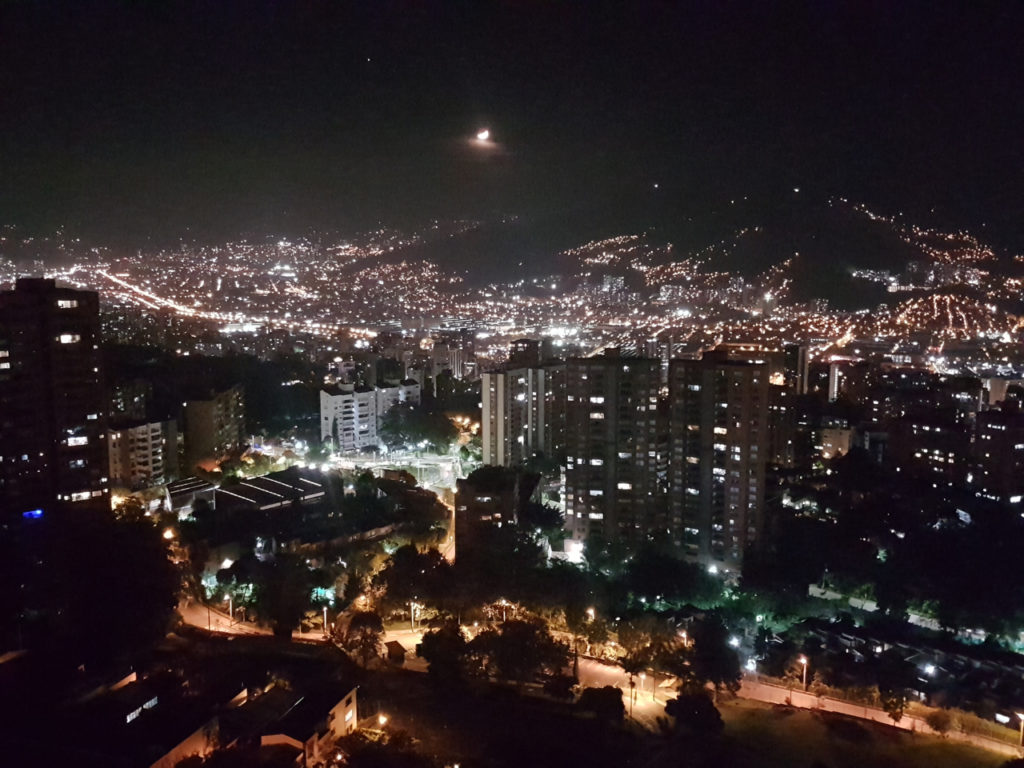
Medellin 
Escobar actually owned a football team. So, that’s one up for him, I guess. 

The outdoor gallery for Medellin’s favourite homeboy sculptor, Fernando Botero 
Real mature, Dave
felt
The Global Literary Treasure Hunt, part I: Colombia! – David Sachs